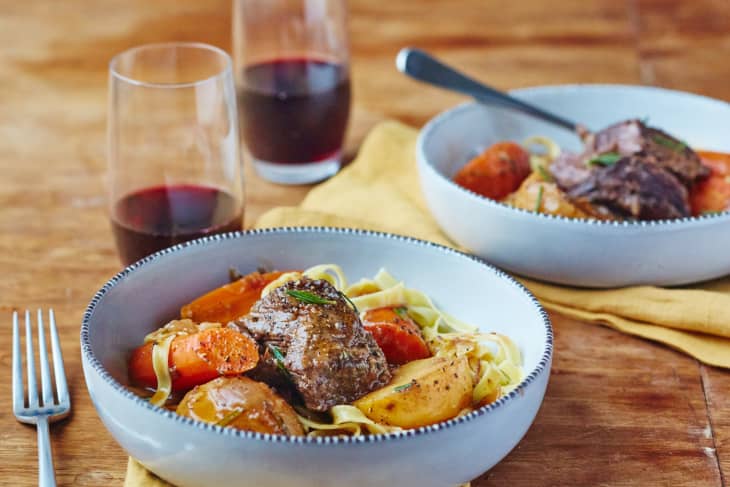How To Fix A Chuck Roast That'snot Dried Out
5 Mistakes to Avert When Cooking Pot Roast

I did non grow up eating pot roast, a fact much lamented past my husband who puts pot roast on his long list of favorite foods from his childhood. In the early years of our human relationship, I tried regularly to print him with a luscious, fork-tender recipe like the one he grew up eating. Many mistake=riddled dishes of mushy vegetables and stringy meat followed before I finally learned a proper technique for this beloved dish.
I tell y'all this just to disprove the folks who swear that pot roast is something you can't spiral upwardly and to share the mistakes I made over many years so you never have to brand them yourself.
1. Using the incorrect roast.
Tough, inexpensive cuts of beef are best for pot roast, which means you can use near any cut of beef, right? Unfortunately the cuts of beef without sufficient connective tissue will either be also tough or plough to mush in a long, tiresome oven braise.
Buy these roasts instead: Wait for a chuck, brisket, or round roast for pot roast. They each contain enough connective tissues that will slowly pause downward into rich collagen, tenderizing the beef and flavoring the gravy every bit they cook.
2. Non browning the roast.
Browning a relatively large roast feels like an arduous task, and since many argue that searing does nothing to make a roast juicer, information technology is tempting to skip the step all together.
Do information technology for the browned bits: Browning, not searing, is a pure flavour enhancer that costs yous zip more than a few extra minutes at the stovetop. Plus the browned $.25 are the culinary equivalent to gold — but a little chip goes a long manner to make the overall dish even better. Brown the roast in the same pot y'all'll braise the beef in after deglazing.
iii. Deglazing with just broth.
Deglazing releases all those lovely browned bits created while browning the roast, merely while a pot roast congenital entirely on beefiness broth will be bulky, it will as well gustatory modality a flake flat and one-note afterwards braising.
Utilise broth plus this instead: Use crimson wine (or fifty-fifty cerise wine vinegar) for the first phase of deglazing. Add together beef broth, a bit of love apple paste, and fresh herbs before covering the pot roast and cooking the beef.
iv. Cooking the vegetables too long.
I long thought of pot roast as a one-pot wonder in which I could throw all my ingredients into a pot and the right amount of time would magically make my pot roast and its vegetables fork-tender at the same fourth dimension. Many mushy vegetables later I learned that the beef should swim solo for a while in the braising liquid earlier the vegetables become in to cook.
Timing is everything: Cook the beef roast for 1 1/2 to 2 hours before the carrots and potatoes (or parsnip, turnips, or other hearty vegetables) go into the pot.
5. Not thickening the gravy.
Gravy, I think, is one of the great distinctions between beef stew and pot roast. The liquid from pot roast should be thick and velvety — not just slightly thickened like stew. The challenge is finding a method for thickening the gravy mail service-braise that won't cause lumps or dirty some other pan.
Try this instead: Make a paste of softened butter and flour and whisk information technology into the braising liquid later braising. This paste is similar to roux — the butter coating the flour prevents lumps — but goes past the name beurre manié.
Do y'all take any other tips for making the best pot roast? Allow us know in the comments!
How To Fix A Chuck Roast That'snot Dried Out,
Source: https://www.thekitchn.com/mistakes-to-avoid-when-cooking-pot-roast-242524
Posted by: brownfrophe.blogspot.com


0 Response to "How To Fix A Chuck Roast That'snot Dried Out"
Post a Comment